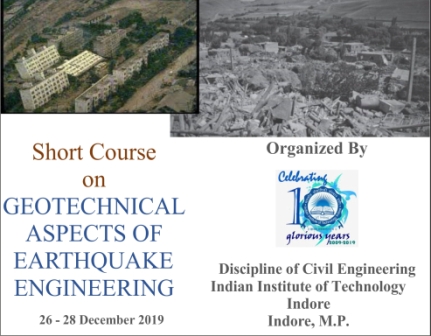Date: 26 – 28 December 2019
Organized By: Discipline of Civil Engineering, Indian Institute of Technology Indore, Indore, M.P.
Download Brochure Here
About IIT Indore
IIT Indore located at Simrol, Khandwa Road, Madhya Pradesh, is one of the eight new Indian Institutes of Technology (IIT) established by the Ministry of Human Resource Development (MHRD), Government of India in 2008-09. Recently IIT Indore makes its debut with a rank of 351-400 in the Times Higher Education World University Rankings 2019. For more details visit: www.iiti.ac.in
Important Dates
Last Date for receiving filled registration: December 10, 2019
Notification of acceptance: December 12, 2019
About Course
India has experienced the most disastrous earthquake like Assam (M=8.7), Kaogra 1905 (M=8.6), Bihar-Nepal 1934 (M=8.4), Assam-Tibet 195(M=8.7), Uttarkashi 1991 (M=6.5), Latur 1993 (M=6.4), Jabalpur 1997 (M=6.0), Chamoli 1993 (M=6.8), Bhuj 201 (M=7.6), Kashmir 2005 (M=7.4) and Sikkim 2011 (M=6.9), Kashmir 2015 (M=5.7), Bharatpur 2015 (M=7.3), Tripura 2017 (M=5.7), North-east 2018 (M=5.5), Mirpur 2019- (M=4.7), Jhelum Punjab 2019 (M=5.6) in the recent past.
The large and rapidly growing urban seismic risk, particularly in development countries like Indi is a problem that needs to be quickly solved. Urbanization s rapidly increasing in every city in India. Huge infrastructure developmental plans have been laid in all these cities which are demanding trained structural engineers/consultants in a large number. It is observed that large concentration of damage in specific areas during an earthquake is due to site dependent factors related to surface geological conditions and local soil altering seismic motion. To reduce the gap and transfer the knowledge many workshops, seminars, sort courses and technical lectures were conducted by IIT Indore, t bring the awareness amongst the professional engineers.
The course is designed to have a broader review on the various aspects of Geotechnical Engineering interlinked with Earthquake Engineering. Each of these lectures during this short course addresses specific issues from the beginning to end (from engineering seismology to Earthquake resistant design). The course lectures cover both fundamentals and applications including hands-on experience in seismic design of sub-structures.

